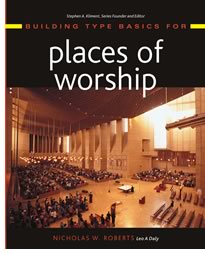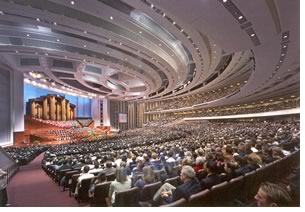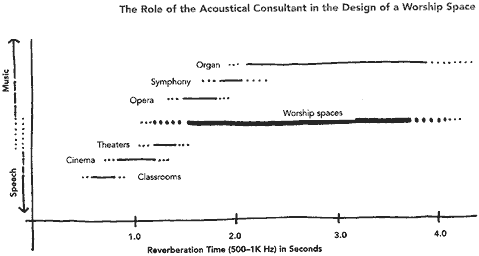

Good Worship Space Acoustics Work for Both Speech and Music
 by
Dennis A. Paoletti, FAIA
by
Dennis A. Paoletti, FAIA
Reprinted from Building Type Basics for Places of Worship
“In the beginning was the Word,” says the book of John—then came music. The sensitive balance between speech and music for worship facilities subsequently became a concern for clergy, worship leaders, architects, and acoustical consultants.
The uniqueness of
worship space design
The acoustical and audiovisual aspects of worship spaces differ from those
of most other building types in a number of ways:
- Projects are unique in that their “spiritual” nature often results in architectural forms and volumes that are individually distinctive and acoustically challenging. There are often conflicting and extreme acoustical requirements for the same major worship space—for example, a “live,” reverberant space (long reverberation time) to enhance and support music and singing and, at the same time, a “dead” space (short reverberation time) to allow for clarity of speech.
 Whenever
acoustics and audiovisual systems are a high priority, it is important
to involve the acoustical and audiovisual consultant early in the architectural
design process. This will forestall incorporating insurmountable problems
into the project later. Once the client, sponsors, and/or the public
see any initial conceptual image(s) of the building, they are often
unwilling change the basic design concept.
Whenever
acoustics and audiovisual systems are a high priority, it is important
to involve the acoustical and audiovisual consultant early in the architectural
design process. This will forestall incorporating insurmountable problems
into the project later. Once the client, sponsors, and/or the public
see any initial conceptual image(s) of the building, they are often
unwilling change the basic design concept.- Acoustics, audio, and video system designs are based on well-founded laws of physics. The success of the ultimate solution will depend on how well these principles are understood and implemented by the design team. The degree to which the consultant can communicate creative recommendations, both aesthetically and technically, will undoubtedly influence the final solutions. A successful design is a collaboration among the acoustical consultant, architect, and engineering design team. Effective communication and close collaboration are essential for reaching a good acoustic design.
The ultimate acoustical
challenge
From a purely technical viewpoint, the religious denomination is not the
issue in the acoustical design of a worship space. Because speech and
music are present in most worship environments, the decision that must
be made at the beginning of a project is the balance between how acoustically
“live” or “dead” the space should be. Will the
space be more reverberant for music, singing/chanting, instruments, and/or
organ, or less reverberant for the spoken voice and only limited music?
Once this criterion is established, the task is to apply the appropriate
acoustical principles to the physical design created by the architect.
Mosques, cathedrals, and worship facilities for Greek Orthodox denominations are typically more reverberant than facilities for the Church of Jesus Christ of Latter-day Saints, which emphasize the spoken word, or Evangelical worship spaces where the emphasis is on sound amplification and the room acoustics are geared to those of a broadcast studio.
The role of the acoustical
consultant in the design of a worship space
The design team for a new worship space, or the renovation of an existing
one, typically includes an architect, an acoustical consultant, a music
minister or choir director, a liturgical specialist, representatives from
the pastoral staff, an organ builder, and interested laypersons of the
congregation, most often known as a building committee. During the programming
phase of the project, the building committee and the rest of the design
team are questioned by the acoustical consultant to determine what constitutes
good acoustics for their congregation.
 Questions
for the music minister include:
Questions
for the music minister include:
- What is the relative importance of music versus speech?
- Is electronic reinforcement of the choir, soloists, or instrumentalists desired?
- What style and liturgical function of music is preferred during worship?
- What are the size and configuration of choirs, hand-bell ensembles, organ, pianos, other instrumental groups, etc.?
A calendar of past years’ activities can be examined for the number and types of special musical programs, including Christmas pageants, Easter cantatas, concerts, recitals, as well as purely speech-oriented programming such as drama or lectures. The music minister is a good source of information as to the direction of the musical program, and the pastoral staff and congregation are key references concerning speech reinforcement within the worship space.
The acoustical consultant questions the building committee regarding the acceptability of visible sound reinforcement elements in the worship space. The consultant provides an explanation of good sound system design based on speech intelligibility, sufficient loudness of speech and music, and the desirability of “directional realism,” which is the perception that the amplified sound is coming from the person speaking. Topics of additional concern include the visibility and reinforcement of the choir and importance of congregational singing.
The acoustical impact of carpet and pew cushions on reverberation, and the control of reflected energy in the case of partial audience seating capacity, are important issues. The requirements for flexible seating within the sanctuary and the use of fixed pews, seats, or movable chairs should be determined.
The consultant:
- Questions member of the pastoral staff as to their public speaking styles in relation to the congregation
- Confirms their requirement for speech reinforcement
- Discerns whether a wireless microphone system is desirable or necessary
- Determines requirements for recording, for example, for archival purposes, duplication for availability immediately after a service, distribution to shut-ins, lectures or guest sermons for distribution and sale, weddings, or other important events in the worship space
- Attends a worship service to observe the style and content of the liturgy and notes conditions or practices that differ from the information supplied during interviews with the music minister, building committee, preaching, staff, and organ builder; much can be learned from direct observation and participation
- Helps to shape the sidewalls and ceiling of a space to promote natural reinforcement of sound, when appropriate, and begins to identify potential locations for the sound reinforcement loudspeakers.
 Emerging
trends
Emerging
trends
The emerging trends in acoustics involve the use of electronics for room
acoustical analysis. In addition, sophisticated computer-controlled audio
system designs are using electronically “steerable” digital
directivity control (DDC) line array loudspeakers. These loudspeakers
can maintain a high level of focused direct sound in a very reverberant
space. The loudspeaker produces a coverage pattern that is extremely narrow
vertically and very broad horizontally. When placed on the floor, the
loudspeaker’s center of acoustic gravity is slightly above seated
head height. These loudspeakers are very tall (often 10 or 16 feet high),
but narrow and thin (e.g., 12 inches wide and 4 inches deep), making them
less visually obtrusive than most other types. Some recent experience
indicates the clarity is so good with DDC loudspeakers that the reinforced
sound no longer sounds “natural” for a reverberant worship
space. At the request of the owners, additional low-frequency energy has
been boosted in some systems (via sub-woofer loudspeaker units) to create
more “fullness” to increase the perception of reverberation
expected in a worship space.
Digital technology is also available to electronically simulate almost any type of acoustical environment. These systems are best used in an acoustically dead environment, where the listener’s aural perception can be controlled totally by the electronically enhanced sound system. Full surround sound, reproducing the expected reflected sound energy patterns from nonexistent architectural surfaces can further enhance the listening environment.
Computer modeling technology is becoming increasingly sophisticated and easier to use. Programs are available that allow a consultant to develop numerous alternative acoustical designs during the design process, so that one will not have to wail until the worship space is built to know what it will sound like. Modeling programs are continually being refined. Architectural computer-aided design (CAD) programs are being integrated into acoustical consulting analysis programs. Some programs can be used for room acoustical analysis and sound system design.
Architects, along with structural engineers, will undoubtedly continue to create exciting, imaginative structures with grand, soaring interior spaces for worship. The tendency to use smooth, hard, sound-reflective (e.g., concrete masonry plaster, and glass) will likely continue resulting in highly reverberant spaces. Herein lies the opportunity for a new set of electro-acoustic solutions. Technological advances can assist the acoustical consultant to analyze and solve the challenges presented to these architectural and structural concepts.
Copyright 2004 John Wiley & Sons Inc. Reprinted with permission.
Copyright 2004 The American Institute of Architects.
All rights reserved. Home Page ![]()
![]()
 |
||
Building Type Basics for Places of Worship, by Nicholas W. Roberts, AIA, is the latest in John Wiley & Sons Building Type Basics series founded by Stephen A. Kliment, FAIA. Chapter 12, “Acoustic and Audiovisual Considerations,” is by Dennis A. Paoletti, FAIA, Shen Milsom & Wilke/Paoletti Inc. Order from the AIA Store online. To see this and scores of other Best Practices, visit the new AIA.org Web site. The AIA collects and disseminates Best Practices as a service to AIA members without endorsement or recommendation. Appropriate use of the information provided is the responsibility of the reader.
|
||
